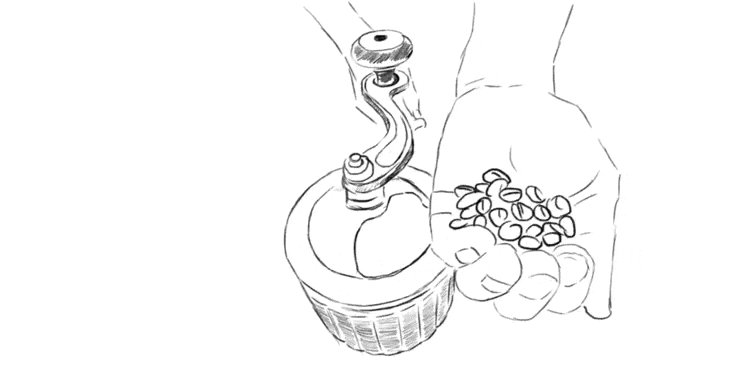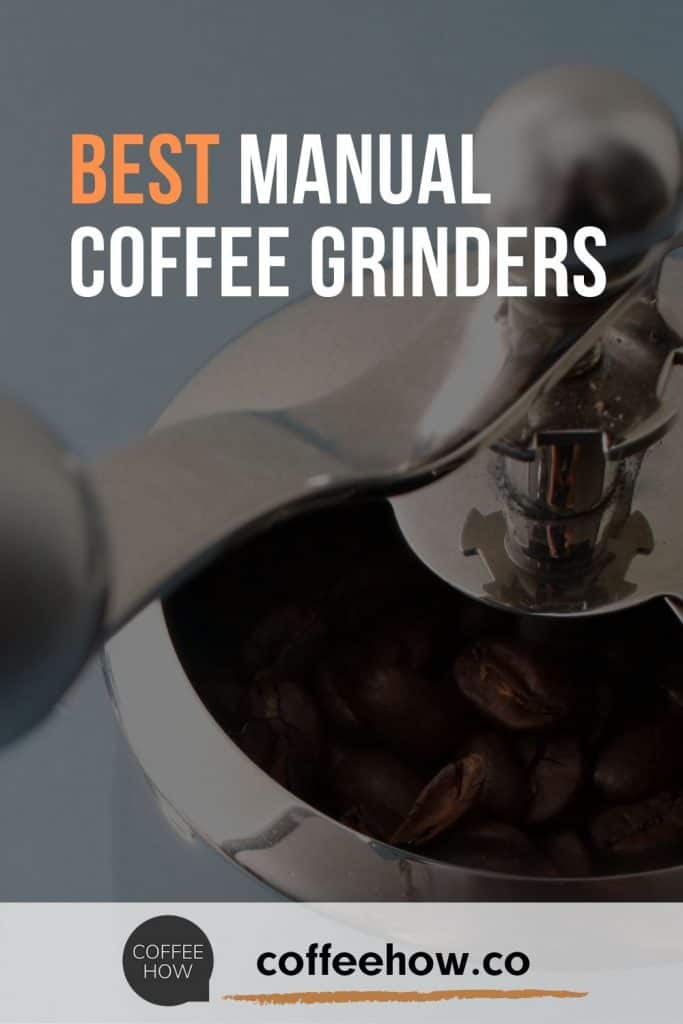Many of us start our day with a much needed cup of coffee. We watch…
Can you improve your favorite cup of coffee?
You already love what you’re drinking. How can you bring it to the next level?
— Well, by using fresh-ground coffee. Your coffee experience will start way before you drink your cup. True, coffee grinders can range from being very cheap to ridiculously expensive. Making the right choice can be a little confusing.
Why bother, if you can buy ready to use ground coffee anywhere?
— Before talking about buying a portable coffee grinder, let’s see why a manual espresso grinder is a good investment. Let’s also consider some things before you buy one. There are a few things you must look for when looking for the best manual coffee grinder.


You can't go wrong with a hand coffee grinder. It’s so portable it would be amiss not to have one. Many of us are on the go and spend a ton of time either at work or school. It’s compact enough to carry in your bag.
One and most important feature of this manual coffee grinder is its construction. This company gives you a one-year warranty and promises the burrs will last up to 300 kg of coffee. That's a long time!
It comes apart for cleaning and is easy to assemble back. No tools needed. Something notable is that you don’t have to worry about resetting the grind size. I’ll stay as you left it when you put it back.
The conical and triaxial design of the burrs almost guarantees a perfect grind. You can appreciate that thought and design went into building this beauty. It’s not too heavy, so you can take it to the woods without overloading your pack. At less than a pound, you won't regret carrying the extra weight during your hike.
Although I’ve highlighted its portability, it can work well in any kitchen. It’s the size of a Coke can, easy to tuck away anywhere.

The JavaPresse Manual Coffee Grinder is a nice-looking model. I think it’s gorgeous! Made out of stainless steel, it matches beauty with performance. At only 9.6 ounces and 7.5 inches long, a great companion to take to work, camping, or hiking.
One feature that I really like, is the burr locking mechanism. This is JavaPresse’s unique design, so there is more consistency in the quality of the grind. I’m sure you don’t want anything to spoil your coffee ritual early in the morning or during those afternoon breaks at work. I see myself cranking this thing in the woods while waiting for my water to boil over a fire.
I’ll hint that the JavaPresse Manual Coffee Grinder is in my opinion the best hand coffee grinder. One downer for some is the hopper chamber, less than 2 inches thick. Loading the coffee into the coffee grinder, using a large scooper, might be a bit difficult. You can get around that by using a tablespoon or even a flexible scooper. Nothing is perfect. And it’s cheaper than the Hario.

It keeps getting better as we continue our reviews. The Timemore with Z Handle is a great manual coffee grinder and has a well-deserved spot on our best manual coffee grinder list. On aesthetics alone, the Timemore is a keeper. It’s also very light and promises a grinding chamber large enough to fit 25 g of your favorite beans.
The conical burrs are manufactured using computer-aided technology. This guarantees a quality, an even burr. Those little teeth you see on the burrs are precisely “carved” time after time. If you need replacements, you’ll get identical burrs to the old ones.
Another feature about the burrs is the fact that they have an official hardness rating. You feel better at dishing out your money when you know you’re getting quality.
The “Z” handle design makes this handle not just a design motif, but it makes movement easier.

This next model is one of the best manual burr grinders out there. It’s very popular and a bit more expensive. Three times as much, but you are getting a well-constructed grinder.
Compared to the previous manual coffee grinder it feels less fragile. To be fair, the burrs also have some play, that may cause an uneven grind if you are using a coarser setting. It’s made out of plastic, glass, and stainless steel. It comes with a silicone grip to help you secure the base as you grind.
Remember, you still have to crank, it’s a manual espresso grinder.
Although it ranks at #12 in popularity at Amazon, it’s shy of reaching 5 stars by very little. To some, the best hand coffee grinder out there. Many have figured out some hacks, like using a mason jar instead of the glass container it comes with.

This 1Zpresso manual coffee grinder is similar in specs to the first one. One thing different is that it has a bigger grinding chamber with a capacity of 30g. It’s also made from high-quality 304 stainless steel.
Although this coffee grinder has the same technology as the Q2, the burrs are of different quality. It’s not bad, just different. You get 40 different settings to play with.
One remarkable thing about this grinder is the handle. If it was too short, you would use more energy, effort, when cranking. Because is longer you get more leverage. This makes a lot of sense.
It also looks good. Made from wood, polycarbonate, rubber, 304 Stainless-steel, and aluminum alloy.

Overall, this next hand grinder is a great choice as well. It’s very portable, weighing only 8 ounces (ca. 302 g). It doesn’t have the same specs as the previous, but at a cheaper price, you can overlook the differences. This item is made in Japan. At least that is what they state in their copy. The point is that Japan makes products that are very practical and well-made. They have a reputation for quality.
The burrs in this hand grinder come apart and are made from porcelain. Not a bad choice. It comes with instructions and an easy-to-follow chart of the burrs’ assembly.
There are some different versions of this manual coffee grinder starting from 2011. That means their product is popular with the consumers. The company has made improvements over the years so expect to pay more for a newer model.
Make sure you put everything together nice and tight and don’t forget this applies to the handle as well. Some people complained about the handle coming apart. The burrs are important but so is the handle. It has a 20 g capacity. Remember, that the grind’s coarseness will affect what you can yield at one given time. You may get 16-18 g at a medium grind setting.

This grinder has ceramic burrs. It’s made from glass with an aluminum handle. It has the biggest grinder chamber so far, 100 g. The grinder mechanism, gears and such, are on top, propelled by a hand crank mounted sideways. This could be helpful since cranking in this position feels more natural. If the materials were better, perhaps this grinder would last a long time.
It looks like a candy jar, a perfect decorative piece in any kitchen think I would haul it around in my travels. It weighs two pounds. Your settings are limited to 15. This precision grinder is not as precise as its name leads to believe. If you are not making espresso, then this would be a budget-friendly alternative worth considering. Make sure it’s sitting securely on a flat surface. Most of it is glass.

Although at a glance, the Vevok Chef grinder might not impress you, it’s a great little grinder. It comes with conical burrs, machined with precision for consistency. The container is small and is made from glass. Make sure you have a firm grip on the body before starting to crank. Some people report smashing the bottom part of the grinder this way.
It’s a little shy of one pound and only seven inches tall. Fits well in any travel pack.
The handle feels very sturdy, and it has some weight to it. This is not a table grinder. You can use it at home, though. It's best to wrap one hand around the body and crank with the other to avoid it from slipping away.
The number 1 setting is the finest, 6 the coarsest.
Cleaning it is not as easy as the other ones we reviewed. Do not attempt to wet the burrs thinking they’ll dry by the next day. Stainless steel is not corrosion-free. The best way to clean this grinder is to brush off any residues. You could open the burrs up by dialing up to the 6 settings, shake and brush anything left in the chamber.

If you are looking for the best-looking manual grinder out in the market, this is it. It reminds me of an old wooden stove.
Furthermore, it’s made in Europe from beech wood. The black model in the link is stained and protected with beeswax. It has a nice little drawer where the ground coffee is collected.
The burrs are simple, conical, and made from carbon steel. Don’t be alarmed by this. Carbon steel is natural, common steel, used in many applications such as tools and meat grinders. Although stainless steel has corrosion advantages, carbon steel burrs stay sharper longer.
The mechanism is simple. You adjust the grind by adjusting the handle nut. This is very like adjusting a pepper mill.
There’s going to be some trial and error until you get the perfect grind. The setting will not stay intact for the next time. You would have to adjust it again.
This is not sold as a portable grinder, although its not that heavy. You might want to take it to the office and show it off. You have four styles to choose from.

I wanted to review the Even Grind, also at Amazon. But at the time of writing, it had become unavailable. The LHS is a great alternative in the same price point range. It’s made of ABS plastic, stainless steel, and ceramic. Don’t be too concerned about the ABS plastic so much. This type of plastic is used in professional wind musical instruments. It’s food safe.
One feature I like is that you can adjust the grind size easily, by just turning the dial that’s built into the body. Other similar models don’t have this feature. This feature makes it very easy for you to tweak your grind.
I would place it among one the most reliable hand grinders for medium-coarse coffee. You may have good results with other grind sizes. But I say that, because, at this price point, you can’t expect a 100 percent reliability. One flaw is that it has a bit of play, looseness, in the burr mechanism. Remember, you’re getting a cheap portable coffee grinder. The price is incredible and it does the job.

The coffee you buy at the supermarket is not as fresh as you think. It’s probably canned or bagged, and stamped with an expiration date. Before it was packed, right after it was roasted, it was left to rest after grinding, for at least 24 hours.
So your coffee, fresh out of the can, is not that fresh.
To be fair, yes, they also get old. Oxygen makes them decay, and they lose their freshness. But the sugars and distinctive flavors we love, are kept safe inside the bean until you grind them. It’s then, that you’ll start your coffee experience even before you brew it. That unique aroma of fresh ground coffee takes you into another zone. So we need to get the best manual coffee grinder that we can afford.
Another benefit of grinding your coffee beans is you can grind it to the coarseness you want. Let’s say you want to make cold brew. For that, you’ll need a very coarse grind, so it’s easy for you to filter the coffee after 16 to 24 hours. Imagine the mess, if it was too fine! The cleanup would make you think twice about trying homemade cold brew again.
Different styles of making coffee require a different type of grind. Fine to very fine for espresso and medium for the typical everyday coffee maker. If you make coffee, for example, in a regular drip machine, using a very fine grind, you’ll probably end up with grounds in your cup. Open the lid and look at the filter. You’ll find a mess, grounds all over the place. That’s because the grind was too fine and the water could not drip down fast enough.
Maybe you might want to try to make some Turkish coffee. Then the grind has to be as fine as flour. A manual grinder would be the best tool for you to do that.

A burr is a part, inside the grinder, that crushes your beans. It could be made out of metal or ceramic.
The price of your grinder will most likely tell you the quality of your burrs. Just like we talked about oxygen aging your coffee, the heat that’s generated by an electric grinder can “cook” it passed its point. The ceramic type burrs, do a better job of keeping the heat away from your precious beans.
Because we’re talking about manual grinders, the metal ones would not be a bad choice either. I don’t think anyone is going to crank one as fast as the cheapest electric motor. Heat, with manual grinders, won’t be so much of a problem.
Ceramic burrs are the choice for grinders aimed at the home coffee brewer. Don’t be put off by the term “home”, like if it was a toy, reserved for the “wannabe” barista. In a commercial environment, a super expensive grinder is a must.
You, on the other hand, are looking to grind just enough for a cup or two. Ceramic burrs won’t get dull. But they are likely to crack, especially if you use a lighter roast of coffee. The darker the coffee bean, the less dense it’s going to be. I’ve seen super expensive grinders struggle with some fancy light blends.
All beans have different density. Dark roasts can be dangerous to your burrs also, for example, a French roast. A quick remedy for that is to start cranking slowly. So the issue of which one is best is a matter of personal choice. Humanity has preferred metal forever, with no problems.
I think now we can start talking about 3 of the best budget manual grinders. Then, I’ll give you my recommendation.

You don’t have to break the bank to own the best manual coffee grinder. Yet, the more you spend will give you better options in better quality.
Ask yourself how much you can afford and are willing to spend. If you are passionate and cherish your coffee experience you want to spend in something long-lasting.
Buying something lower quality results many times in spending more because you end up buying another grinder after realizing your first one was a bad investment.
Not all grinders are created equal. You want a grinder that will withstand cracking and handling. Although the outside barrel does not have to be super strong, the burrs and the mechanism have to be strong and preferably made from steel. Personally, I would go with carbon steel because is sharper than stainless steel. Porcelain is not a bad choice.
Glass can break easily if you are not careful, so a grinder mainly made of this material might not be for you?
The point of using a grinder is getting the perfect grind size. A precisely machined set of burrs, using the best metals, will hike up the price of your grinder. The quality of your grinder depends on the burrs. You should also be able to easily and precisely adjust them to the correct coarseness. For that, you should be able to move the distance between the burrs easily. The smaller the gap, the finer the coffee.
If you are making just one cup of coffee, then a 20 g model will do. It will yield you about 2 cups of coffee. Now, if you’re entertaining and need 10 cups of coffee, then a 100 g capacity will be what you need. Don’t be tempted to just buy a bigger grinder, so you can grind enough for a week. Aim for freshness, grind as you need. If you want to grind in bulk to store away coffee, buy vacuum-sealed ground coffee, and it will keep fresh over a year.

If you intend to take the grinder in your next hike, stick to small units. A pound is a lot of weight to a hiker. A hand crank coffee grinder would be a great choice for people that work on the road and like to take their special tools with them everywhere they go. Most grinders in our reviews are worth taking along when on the go.
Here is when you really know who is who in quality. A warranty of 5 years is rare, yet the Zassenhaus promises their burrs mechanism will work fine that long. Most of the ones we reviewed come with a warranty. If the manufacturer stands by their product, rest assured the hand crank coffee grinder will last at least that long. With care and regular cleaning, it may even outlast its intended life.
No matter which type of grinder you buy, you still have to dial in the right coarseness. So whether you want to crank or push a button, getting it right depends on your know-how rather than on how fast you do it.
One advantage of a hand crank is that it doesn’t generate much heat in the burr system. An automatic grinder will be best suited if you would need to grind a lot of coffee. Although realistically speaking, the average user won’t be in this position.
The best manual grinder will work anywhere, without any electricity. Additionally, coffee making is so personal, that cranking your dose becomes special.
Yes, you’ll find many high-quality manual coffee grinders available. They come with a wide range of grind settings. Be sure to get a burr grinder. Whether electric or manual, a metal burr grinder or ceramic burr grinder produces a uniform grind.
For most people, manual grinders are very easy to use. It does take some time and effort, but the average person should have no trouble turning the crank. The physics at work inside the machine transforms the wide circles of the crank into precision, bean-cracking power.
We will note that if you’re grinding a lot of coffee beans, your arm may get tired. Finer grind settings may take a little more effort than for a coarser grind like for the French press.
Depends who you ask.
Many prefer the up close and personal experience of grinding their own coffee beans. Other advantages include quiet operation and greater durability.
Also, you’re not dependent on a power source. You can take your hand grinder anywhere, even on a backpacking trip!
Another big benefit of a manual grinder is that they’re much less expensive than electric ones. However, if you want to grind a large amount of coffee, then an electric grinder can be a godsend.
For most manual grinders, you set the grind settings then fill the top chamber with whole coffee beans.
The grind settings range is usually at least from espresso to French press. As you turn the crank, the burr grinders crush the beans. Once the grind is a certain size, it will fall to the lower chamber.
With electric grinders, ceramic burrs are usually best. But with manual coffee grinders, metal and ceramic burrs are equally desirable. Prices usually reflect the quality of construction.
Our personal favorite is the 1Zpresso Q2 Manual Coffee Grinder. 1Zpresso is all about the details, which is evident in their patent-pending design.
This, in part, depends on the grind settings. If you want medium ground coffee, it takes about a minute to grind enough for one cup of coffee.
You can find a hand coffee grinder, like the 1Zpresso Q2 Manual Coffee Grinder, that takes less time. Making fine ground coffee will take slightly more time than coarse ground coffee.
Most manual grinders have a simple setup. With some, the only assembly required is screwing on the handle. Others may have a few nuts and rods, but they will still be easy to put together. Be sure to refer to your user manual to see the proper setup for your particular grinder.
Your manual grinder will probably have either a dial adjuster or a ring adjuster. Units with dial grind settings are usually easier.
Typically, these are on the bottom of the hand coffee grinder unit. With a ring hand grinder, you may have to disassemble the unit. After turning the adjustment ring, be sure to secure the ring lock.
Yes! We can’t stress this enough.
Freshly ground coffee beans are essential for a great cup of coffee for any brew method, from espresso to French press.
Once cracked open, the components that contribute to flavor and aroma quickly deteriorate. Coffee is best when used within a few minutes of grinding.
Regular cleaning is essential for the longevity of your manual grinder and for the quality of the brew in your cup. Remove old coffee grounds daily or weekly and perform deep cleaning a few to several times a year.
Use a brush to sweep away any coffee grounds from the burrs at least every two weeks. Personally, I try to do this after every use. Many manual coffee grinders come with a brush just for this purpose.
Do a deep cleaning of your manual grinder every few months. Coffee contains oils. When these oils build up, they can go rancid and ruin the taste of your coffee. You’ll need to disassemble your hand grinder and use warm, soapy water to thoroughly clean the burrs.
This depends on the brewing method you use.
Turkish coffee uses a very fine grind, more like a powder.
Espresso uses a fine grind.
Automatic drip and manual pour-over coffees use grinds in the medium range.
A French press requires a coarse ground, and cold brew needs the coarsest grind.
Certainly, what seems like a simple task, turns out to be difficult because we have so many new choices. Manufacturers are always improving their products. Any of the grinders in our review will do an outstanding job, and they are reasonably priced.
The best manual coffee grinder is the 1Zpresso Q2. It’s intended for a coffee enthusiast, and the materials they use, show they have the consumer’s needs in mind. It comes apart for cleaning. We can’t forget either, their unique burr mechanism design.
I just have to say, that the JavaPresse is a well-thought-out product and a very good option to go for. It’s convenient to take anywhere, looks good, and feels good.
Let’s not forget its main purpose: grinding coffee consistently. The fact that the manufacturer has a patent-pending on the burr locking mechanism, shows attention to detail on their part, attempting to solve a common problem with these types of grinders.
If espresso is your method of enjoying coffee, our winner here will do a great job as a manual espresso grinder. It’s the sturdiest of the three.
One final word of caution, alternate arms from time to time. You don’t want to end up with uneven biceps. Just kidding!
